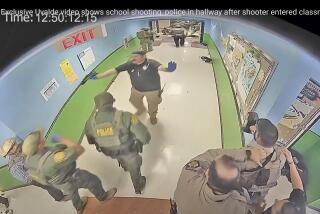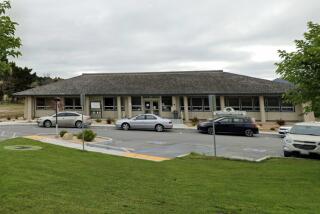A Textbook Case of Student Violence
ATLANTIC CITY, N.J. — An eighth-grade science teacher puts buckets on the floor to catch the rain leaking into her classroom. The buckets soon overflow. In the confusion and mess, a student refuses to work. She tells him to leave, and he stands, takes off his coat and threatens to hit her.
“Is that really what you want to do?” she asks, her voice shaking. “Will that make you feel better?”
As he raises his fist, a security guard bursts into the room.
They are at Albany Avenue School, a cavernous, castle-like structure in Atlantic City, and a place of dubious achievement: more than 700 suspensions, 68 arrests and two knifings since September. Students have attacked each other and their teachers. Other students have set fires. Many have vandalized and roamed the halls, banging on lockers and classroom doors, yelling. Stairwells, bathrooms and the basement have served as venues for sexual encounters.
At the rundown school, 1,830 students in the fifth through eighth grades were registered until January, when a state judge ordered officials to transfer about 500 fifth-graders for their safety. But the violence and disruption continue. Teachers have published a call for help in the local newspaper and boycotted a training session as a sign of protest. “Not only has the administration put the students’ education in jeopardy,” the teachers said in a half-page ad, “but also their physical safety.”
Albany Avenue School is a leading example of the problem of violence in American schools. Nationally, every hour “40 teachers are physically attacked, 900 teachers are threatened with bodily harm and 2,000 students are physically attacked by other students,” says Stephen Wallis, an administrator at a public high school in the Washington-Baltimore area and co-author of a 1997 study of crime, poverty and family structures in America.
Albany also offers a cautionary tale of what overcrowding and bureaucratic infighting can do to a school. In this case, say critics, the district was so adamant about using a rickety, closed school as part of a districtwide restructuring program, and perhaps desperate to keep the building from reverting to city ownership, that it hurriedly reopened the school and stuffed it with students who did not have enough structure or supervision.
Benjamin Williams, the superintendent of Atlantic City schools, says Albany is under control. He has accused the state of rushing to move children out to pressure the district to abandon the structure, opening the way for the city to reclaim the building and turn it into a training center for casinos.
The state education department and Mayor James Whelan label Williams’ accusation absurd. Whelan says the city is in no hurry to obtain the land.
In August, Williams began rehabilitating the school, closed four years ago for safety problems. He removed all of the city’s fifth- and sixth-graders from their neighborhood elementary schools and put them in the school with all of Atlantic City’s seventh- and eighth-graders. Some students had to ride buses for the first time. School opened late. Many teachers did not know their classroom assignments. Many did not have enough supplies. Several did not have desks.
Some of the seventh- and eighth-graders began to prey on the younger students. Some of the children were part of groups who had adopted a gang-like mentality of turf consciousness. Now attending the same school, they began battling.
Albany still is tumultuous. “All these different kinds of kids, from different neighborhoods, put in one place, can’t get along. It’s too crowded. It’s like a zoo,” said eighth-grader Paul Laws.
Graffiti cover bathroom walls. Some ceiling panels are missing, exposing electrical wires. Other ceilings are collapsing. Paint is peeling. One classroom reeks from trash being stored beneath it. Sections of the building are condemned. The school does not have a playground. So after lunch, children mingle, run and wrestle in the cafeteria, where, says a security guard, he saw 19 fights on one day.
“They have us locked up,” says seventh-grader Steven Yarleque, 13. “We can’t even go out. Security guards are everywhere--like we are some kind of criminals.”
In a typical incident, a young girl tussling with a boy was slammed against a locker and thrown to the floor. She slid past an eighth-grade science teacher, who reprimanded her for starting the struggle. The girl threw a punch at the teacher, who blocked it with her arm.
Many teachers are frustrated and scared. “I can’t stand being here,” one teacher says, tears in her eyes. All of them are working without a contract.
“The first time we went to a board meeting and told them what was happening and asked for help, the board just looked at us, like these kids sometimes do when you tell them something,” a learning disabilities teacher says.
The administration, adds another teacher, has “decided to throw 2,000 kids in the trash.”
More to Read
Sign up for Essential California
The most important California stories and recommendations in your inbox every morning.
You may occasionally receive promotional content from the Los Angeles Times.










